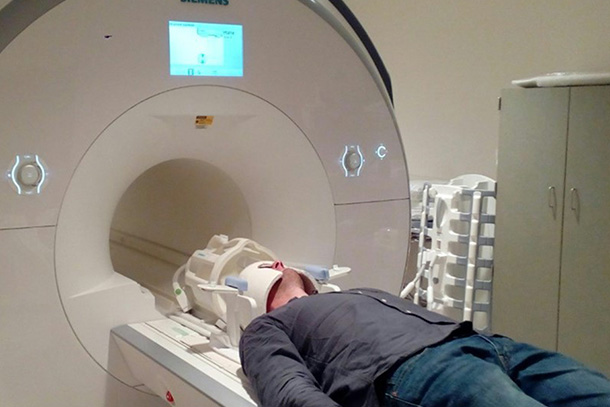
A helmet with ceramic materials inside that enhances an MRI signal would enable shorter scan times and more detailed images of the brain. Credit: HyQ Research Solutions, LLC.
Ceramic material could enable faster and better MRI results
September 7, 2022
By Jamie Oberdick
Editor’s note: This article originally appeared on Penn State News. Michael Lanagan, professor of engineering science and mechanics, was featured in the story.
UNIVERSITY PARK, Pa. — Penn State researchers are leading an academic-enterprise partnership that has developed a new dielectric material for use in magnetic resonance imaging (MRI) machines. The material is designed to deliver higher image resolutions and enable shorter scan times, which may reduce MRI operating costs for the hospital and lessen the MRI-related anxiety suffered by some patients.
“Clinical MRI is often used as a tool of last resort because MRI scans are extremely slow and expensive,” said Michael Lanagan, professor of engineering science and mechanics. “Anyone who has had an MRI knows that you are in there for a half-hour to 45 minutes, and it can be very uncomfortable, with lots of loud noises during the scan.”
Lanagan is among the Penn State faculty members who helped found HyQ Research Solutions LLC. HyQ Research Solutions is using ceramic materials to make MRI pads that enhance the signal and shorten the amount of time a patient spends inside the machine. The company is also using ceramic materials, which may potentially help produce more detailed images of the human brain, to develop an MRI helmet.
“We are working with researchers all over the world to deliver solutions to upgrade their [MRI] coils and to enable them to improve image quality,” Lanagan said, noting that improved brain images could benefit such work as Alzheimer’s disease research. “We are also working with those who study the metabolism of the brain via magnetic resonance spectroscopy, a technology that allows us to ‘see’ the biomolecules inside our body. Our materials are key to getting enough available signal from a very small number of biomolecules in our brain to study the brain functions and related metabolic changes.”
According to Lanagan, the ceramic material increases the signal captured in MRI, which could allow clinicians and researchers to tune their MRI machines precisely to their needs.
“There’s a lot you can do when you increase the MRI signal,” Lanagan said. “If you have a higher signal, you can either scan for less time for faster image acquisition or have better image resolution. You can trade those things off.”
Lanagan, along with company co-founders Qing X. Yang, professor of neurosurgery at Penn State Hershey, and Sebastian Rupprecht, chief executive officer and research and development director of HyQ Research Solutions, have worked on the MRI signal-enhancing ceramic material for more than 10 years. The development of this material led to the founding of the company in 2013, after Lanagan and his colleagues received their initial patent for the novel ceramic material. They worked with the Center for Medical Innovation at Penn State Hershey, the Penn State Office of Entrepreneurship and Commercialization, and with advisers at Ben Franklin Technology Partners.
“Working with the Penn State offices and Ben Franklin Technology Partners has enabled us to receive funding from the National Science Foundation (NSF) and the National Institutes of Health (NIH), along with the revenue from our early scientific customers,” Lanagan said.
This type of academic-enterprise partnership is important, Lanagan said, because it helps accelerate a research concept from idea to prototype to market. Through research service agreements, the partnership had access to Penn State research facilities, such as those found in the Millennium Science Complex, and access to a wide variety of expertise in both materials research and clinical radiology.
“The unique facilities and people that work at a university like Penn State are an incubator to commercialization of research like ours,” Lanagan said. “We still regularly rely on the highly specialized skills and certain equipment that a startup could never have.”
According to Lanagan, HyQ Research Solutions plans take their product to market soon, as well as to wrap up a few related projects, including America’s Seed Fund/NSF Small Business Innovation Research Phase I Award and NIH Brain Research Through Advancing Innovative Neurotechnologies Initiative projects, on which they collaborated with the University of Minnesota’s Center for Magnetic Research, New York University and Stanford.
“There was a lot of research at Penn State over the last decade in this area, and I feel like a lot of it now is mature enough for us to be more independent,” Lanagan said. “For us, this is a time of transition.”



